The 39 Steps, 1935, directed by Alfred Hitchcock, adaptation by Charles Bennett, dialogue by Ian Hay, from the novel by John Buchan.
Nobody but paranoiacs goes to see a paranoid thriller for penetrating insights into the inner lives of the characters. There's no sense in this kind of movie wasting any time putting the characters into mortal peril; nobody wants a long scene of Roger Thornhill pitching a new ad campaign. But no other thriller streamlines the main character's life as drastically as The 39 Steps. Robert Donat plays the main character, Richard Hannay, who is in the wrong music hall at the wrong time, and ends up, as Hitchcock heroes tend to, on the run from both criminals and the law. Everything we know about Hannay's life emphasizes how sketchily drawn and temporary his life is before the movie begins, from cardboard letters in his apartment lobby:
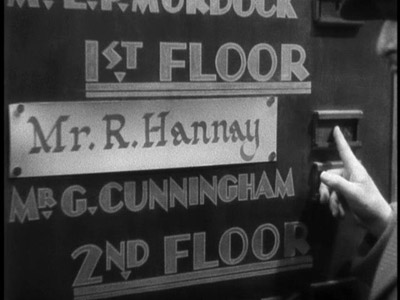
To the apartment itself, where the furniture is still covered in sheets:
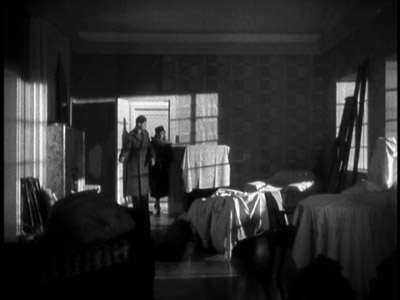
All the movie tells us about him is he's in town for a short time on business and he's Canadian. But as you can see from the sets, Hitchcock does everything he can to impress upon us that Hannay isn't carrying much of a back story with him. Hannay's life really begins when the movie does, at a music hall performance of an impresario named "Mr. Memory." Mr. Memory gets only a few minutes into his act before someone pulls a gun:
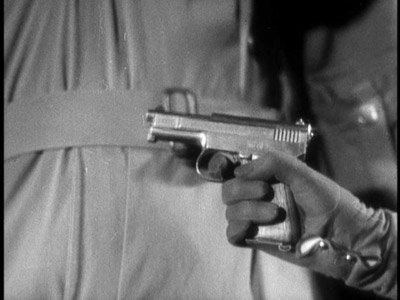
Unfortunately for Richard Hannay, the gun is only seen in a tight shot—so when Lucie Mannheim asks if she can come home with him after the show, he thinks it's just because he's so damn charming.
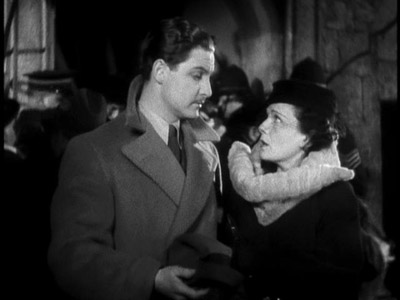
Actually, it's not clear what Hannay thinks, or why he agrees to bring a stranger home with him; he doesn't seem to want to sleep with her (though he does serve her fried haddock, which may be some sort of British code: "so I fried up a haddock, and I'd only met her that night, wot wot!"). Anyway, she tells him, through a thick German accent, that her name is "Annabella Smith," and she's being pursued by men who want to kill her. She adds "something which is not very healthy to know:" unless she can stop it, a vital Air Ministry secret is about to be smuggled out of the country. Hannay, so trusting when it comes to inviting strangers to his apartment, doesn't believe a word of her story. But she proves most of it (particularly the "not very healthy to know" part) that night by staggering through his door and collapsing with a knife in her back.
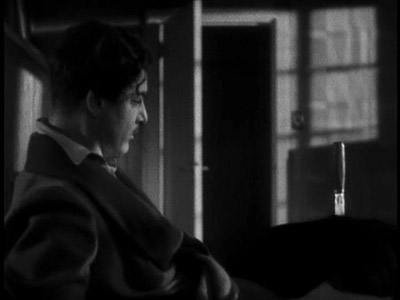
Yes, this is a movie where someone staggers through a door and collapses with a knife in their back. Hannay quite sensibly goes on the lam, and the rest of the movie is basically an extended chase scene, where nobody is quite what they seem and one safe haven after another turns out to be perilous. The first section of Hannay's flight relies almost entirely on paranoid thrills. There's a standout action sequence as the Flying Scotsman crosses the Forth Bridge:
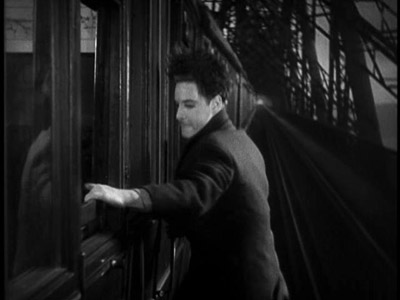
The dominant tone here is not the Indiana Jones-style action that the still above would imply, though; more frequently Hitchcock goes for the kind of tension you can see in this shot, later in the same sequence:
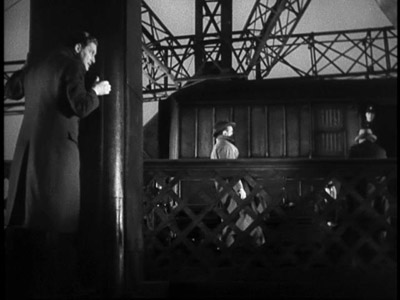
Will they see him? Will he fall? This shot is interesting, actually, because the framing is very self-conscious in deliberately denying the audience important information. Hitchcock tracks right with the train, and when he tracks back to the girder, Hannay is gone; we never find out exactly how he got off the bridge. It's a very self-conscious use of the camera. As with the tight shot of the gun, you can't help but be aware that you're being told the story in a particular way, by a particular narrator, because the framing is so obviously limiting. And if you think of the camera as a narrator, then you have to admit that this one is Nabokovian in terms of sheer manipulativeness. Manipulative is an apt word, actually, because the most obvious example is a long shot at a party where the appearance of one character's hand is a significant clue. The first time you see the scene, you don't notice anything strange about it, right up to the reveal shot:
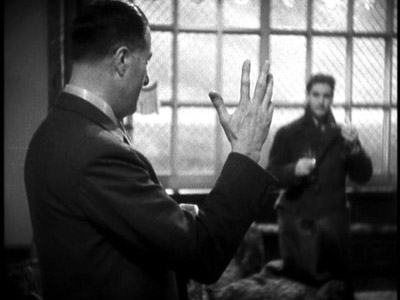
But the second time you see the sequence, you notice how oddly a lot of it is framed to include other people's hands:
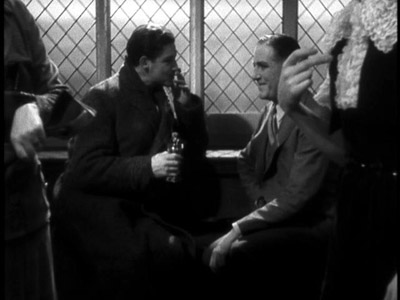
It's the cinematic equivalent of Pnin's birthday (O careless reader!)—like Nabokov's narrators, whoever is controlling the camera here knows there's a clue you're not paying attention to, and is not above taunting you a little. Hitchcock's obvious presence in this film was almost enough to induce me to follow the bouncing ball from privileging mise en scène to embracing auteur theory. But there's a reason Hitchcock's thrillers are so beloved of auteurists: thrillers aren't character studies, and a director has a great deal more control over how and when visual clues are given in a movie where the plot depends on reveal shots. It's easier to be an auteur if you work in a genre that minimizes the contributions of writers and actors.
That's not to say the actors don't turn in great performances, just that this is the kind of movie where actors must be unflappable and charming, not necessarily insightful. Basically, it's the kind of movie you want to cast stars in. That's right, I said stars, plural; there's a romantic female lead in the movie too, Madeleine Carroll:
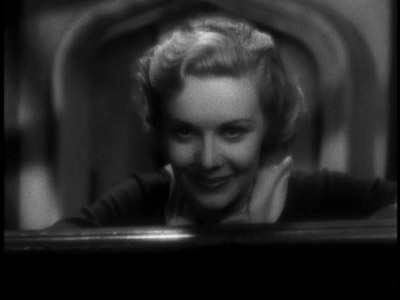
You might be wondering why I haven't mentioned her before. It's because she doesn't show up at all until 25 minutes into the film, when Hannay ducks into her compartment on the Flying Scotsman, kissing her passionately so the cops will walk by. You can tell by the look in her eyes that this tactic is going to have... limited utility:
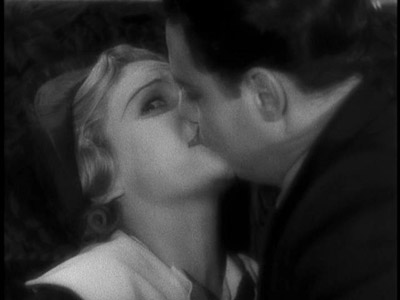
This scene prefigures Eve Kendall's voracious seduction of Thornhill on the 20th Century Limited in North By Northwest, but Hannay could take a few pointers from Cary Grant. Hannay's approach is nearly charmless, and Carroll turns him in as soon as she can. In fact, you could plausibly retitle The 39 Steps as The Importance of Being Charming, because Hannay only succeeds when he's being charmingly dishonest; nearly every time he's honest about anything, he immediately falls into worse trouble.
The movie itself gets a lot more charming when Madeleine Carroll reappears (after the train incident, which lasts maybe sixty seconds, she takes a half-hour vacation from the movie). Up to that point, it's a paranoid thriller with some hints of tragedy (I'm thinking here of Peggy Ashcroft's brief turn as a beaten-down wife, the most nuanced performance in the film). Once Carroll comes back, it undergoes a sudden transformation into a romantic comedy. This change isn't completely abrupt; Hitchcock leads into it with a comedic scene where Hannay hides out in an assembly hall, is mistaken for a visiting speaker, and gives a passionate oration:
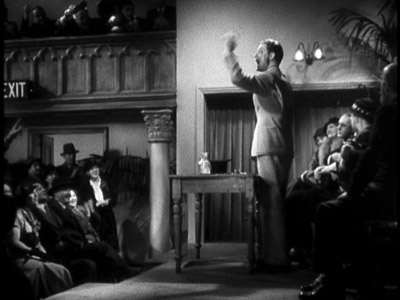
This is probably my single favorite scene in the movie. The speech Donat gives is hilarious ("I know what it is to feel lonely and helpless and to have the whole world against me, and those are things that no man or woman ought to feel!"); this is the point where he quits worrying and just starts enjoying the ride. You can see that when he's escorted out handcuffed to a detective, cheerfully waving to the audience.
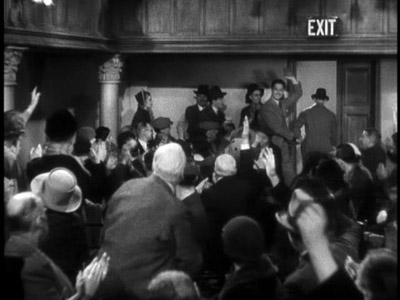
So it's not completely tonally unprecedented when the last half hour of the movie becomes primarily about Donat and Carroll bickering and fighting and falling in love. There's no denying it's a shift in tone, though. It's a long way from this shot of Hannay at the most tense and suspicious dinner ever:
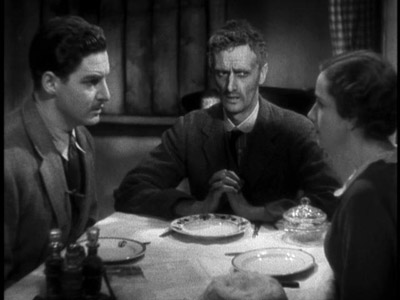
To the screwball comedy aspects of Hannay and Pamela's completely unconvincing impersonation of newlyweds:
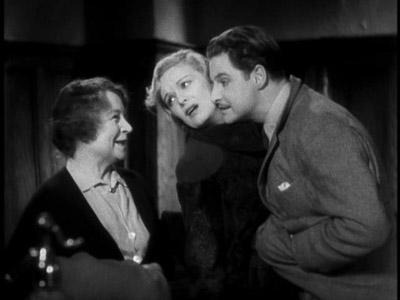
It shouldn't work to have such a dramatic shift in tone two-thirds of the way in, but it all kind of hangs together. For one thing, the last third is a good screwball comedy. Though they're handcuffed together, Carroll always looks that terrified, Hannay always looks that phony, and he's obviously holding a gun against her, the old woman they're fooling is thrilled. For another thing, some of the complications of being handcuffed together are not just funny but sexy. Take Hannay's hand on Carroll's leg when she removes her wet stockings:
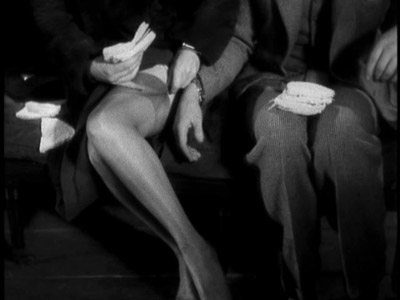
Finally, the tone changes back again by the end, a giant, tense, finale of a set piece. Fittingly, it's at another music hall, and comes complete with a John-Wilkes-Booth-style leap from the balcony:
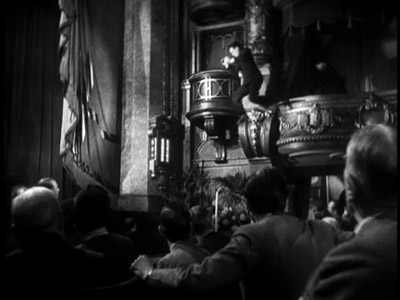
When people praise thrillers, they often describe them as "tight." You can't say that about The 39 Steps. The plot's kind of shambling, characters appear and disappear, one of the leads is only in about a third of the movie, the tone varies wildly, and nobody seems to care too much about the murder that the movie opens with or the government secret that closes it. But it goes from paranoid and strange to charming and funny and back again so smoothly that you don't notice a change, the plot is surprising the first time you see it and the jokes are funny the seventh, and you could write a book about the deliberate way Hitchcock places and moves his camera. The 39 Steps is genre filmmaking at its best (and I love genre films). For one thing, when it comes to thriller/romantic comedies (for further examples see North By Northwest and Charade), this is the movie that invented the genre.
Randoms:
- Hitchcock shot his first movie at UFA and there's a German Expressionist influence in this film. Like this bizarre shot of Richard Hannay's hallway, where the statue points at the window the murderer has just fled through:
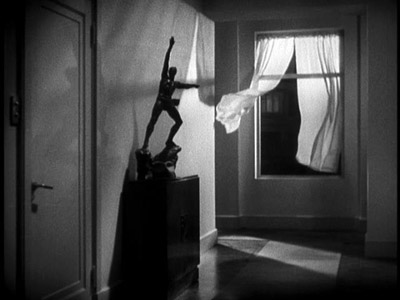
- Or the closeup of Mr. Memory:

- Not much else to say about those except yeah, they're German Expressionist looking, all right.
- Pay special attention to the sequence where Annabella Smith dies for what may be the earliest use of an unanswered phone as a device to build tension. The desire to answer the phone is so Pavlovian that it can make an already tense sequence nearly unbearable.
- The DVD also includes the Lux Radio Theater production of the movie. Lux Radio Theater was a weekly program that presented radio versions of Hollywood movies. There's something really fun about seeing how they compressed the movie into a short radio program and attempted (more or less unsuccessfully) to translate the visual language of the movie into radio (hint: sound effects!). Still more fun is the intermission. Cecil B. DeMille, the show's producer, interviews Major C. E. Russell, a retired spy (whose book is still in print). The interview quite deliberately devolves into an ad for Lux soap, thusly:
Russell: There's a machine recently developed in this country...it could etch a map of the entire country on a single Lux flake. And that's probably the finest thinnest, and most fragile thing that I can think of for the moment.
Simpler times, simpler product placement.
DeMille: I know that you can read through a flake of Lux, Major! It's actually only two one thousandths of an inch thick!
Russell: I see! Almost as amazing as this machine I'm speaking of!
- And speaking of simpler advertising, the advertising for The 39 Steps really is something to behold. The DVD reproduces the original press book, complete with all the film's taglines. Now remember, the movie's about a man who is falsely accused of murder and flees across the country, trying to expose a ring of spies. See if you can tell what's strange about this poster:
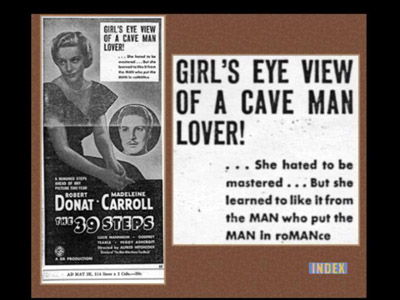
- Donat is the MAN who put the MAN in roMANce because he had just starred in The Count of Monte Cristo. That wasn't even the most misleading tagline; that honor goes to this gem: "She Loathed Him... He Despised Her... And So They Were Married." Well, no. No, they weren't, unless you read a lot more into them holding hands at the end than I think is warranted. Apparently, marketing teams had just as much trouble selling genre bending movies in 1935 as they do now.
- The most unintentionally funny shot is the stock footage of an autogyro chasing Hannay across the moors:
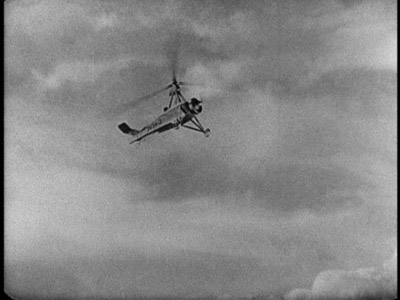
- If that's the secret "vital to England's air defense" that people are dying to keep out of enemy hands, I say they just let it go.

